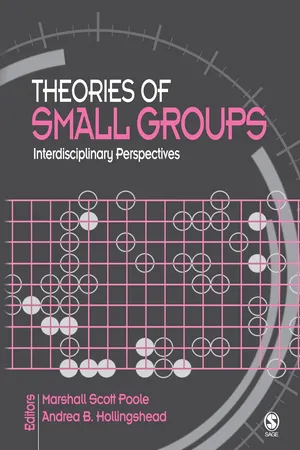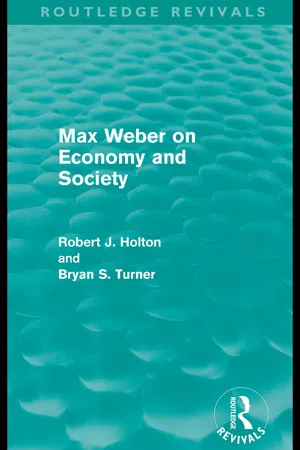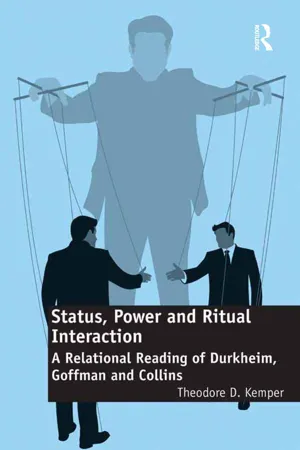Business
Group Status
Group status refers to the perceived position or standing of a particular group within a business environment. It encompasses factors such as authority, influence, and reputation. Group status can impact decision-making, team dynamics, and overall organizational culture. Understanding and managing group status is important for effective teamwork and collaboration within a business setting.
Written by Perlego with AI-assistance
Related key terms
Related key terms
1 of 4
Related key terms
1 of 3
6 Key excerpts on "Group Status"
- eBook - ePub
Status
Why Is It Everywhere? Why Does It Matter?
- Cecilia L. Ridgeway(Author)
- 2019(Publication Date)
- Russell Sage Foundation(Publisher)
multilevel relation that implies actors at one level who are nested within an encompassing group that shares a particular, socially defined standard of value. Once again, this is true for both individuals in an interpersonal group and status rankings among groups in society.If status is a social ranking of self compared to another, according to a group standard, then an actor’s status is fundamentally dependent on the evaluations and reactions of others.19 Understanding this is central to understanding status dynamics. As the classic sociologist Erving Goffman pointed out long ago, status cannot be seized or possessed like material goods.20 Instead, status is more like a reputation. A person can take actions to claim it, but it must be granted by others in the group or context through their reactions to that claim. In Bales’s groups, for instance, an individual could take the initiative to speak up and make a claim on the group’s attention, but others had to react positively to his claim by listening with approval to what he said and accepting his arguments. That status is given, not taken, is one of its fundamental features.Therefore, when two actors judge their status in relation to one another, they do so by drawing on a shared group standard. This standard is, in effect, a cultural belief shared by the group or surrounding society, so that status rankings are inherently based on sociocultural processes of shared beliefs and evaluations. Furthermore, since the actors have a shared recognition of the group standard by which they are compared, both the higher-status actor and the lower-status actor also share their recognition of the social fact of their relative rank. They understand how they are viewed by the group or community. In the status hierarchy of high school, for instance, both the prom queen and Suzie Glutz know where each other stands. In this sense, status hierarchies are consensual - eBook - ePub
Theories of Small Groups
Interdisciplinary Perspectives
- Marshall Scott Poole, Andrea B. Hollingshead(Authors)
- 2004(Publication Date)
- SAGE Publications, Inc(Publisher)
institutional mechanisms or rules that assign the right to make a decision, the right to enforce a decision, or the right to private information that grants advantage. Typically, those institutional mechanisms support Person A’s rights and punish those who do not recognize A’s rights. As we note later, there are other institutional rules that are important for defining characteristics of groups as well as the kinds of power relations that emerge within groups (see Crawford & Ostrom, 1995, for an excellent discussion of the grammar of institutional rules).Status
Intimately related to power is status. Status is defined as a position in a social network. This is a purposely broad definition because it includes status such as mother or sister as well as status such as socioeconomic status or minority status. It is important to see that these statuses involve beliefs about the social worth of the individuals who occupy them, called status beliefs , such that a person who occupies one position is “better than” a person who occupies another position (e.g., Sewell, 1992).Status often provides an “organization” function for groups in that it defines a structure in which power use (and the lack of power use) is acceptable. The acceptable use of power can make a group function relatively smoothly but may at the same time generate an acceptance of inequality. In addition, power use can generate negative sentiment and interrupt the process by which power use translates to status (or further status distinctions, see Lovaglia & Houser, 1996; Walker et al., 2000; Willer, Troyer, & Lovaglia, 2001).Many social scientists (e.g., Weber) have suggested that status significance is acquired through resources. In a well-developed articulation of one process through which nominal characteristics, such as race and sex category, might acquire status value and status beliefs, Ridgeway (1991) developed and then tested aspects of status construction theory. This theory posits one mechanism through which a characteristic previously not status-valued might acquire status value. According to the theory, members differ in the level of material resources they possess, they differ on an unordered nominal characteristic, and resources are correlated with the “state” or category of the characteristic (Ridgeway, 1997). - Robert Holton, Bryan Turner(Authors)
- 2010(Publication Date)
- Routledge(Publisher)
Status groups may emerge as a consequence of their life-style, especially where their life-style is associated with the development of a vocation or a profession, or through the basis of an hereditary charisma (for example, traditional Islamic saints) or through the monopolistic possession of certain political or hierocratic powers (Weber 1978:305–6). In short, status groups are communal groups which, through various means, enjoy certain forms of privileged access to scarce resources, especially where these scarce resources are of a cultural, moral or symbolic character. These status groups are ranked in terms of negative or positive privilege systems. Furthermore, status groups typically have their origin in some strategy of usurpation; they involve a collective struggle to improve access to esteem through usurpatory strategies. A typical example of this would be from the Indian caste system, whereby the adoption of certain high-caste activities brings about an improvement in status; this process has been referred to as ‘sanskritization’ (Srinivas 1952; 1966). Srinivas defined the process of sanskritization as one involving the claim of a low-caste tribal or other group to the status and privileges of a high or twice-born caste. As a general rule these changes in status are followed by a claim to a higher niche in the caste system than that conventionally conceded to the claimant group by the local village community. Finally, in this section defining the formal characteristics of status and status groups, Weber argued that, depending on the currently prevailing system of stratification, it is possible to speak of either ‘status society’ or a ‘class society’. Whereas class societies are at least formally characterized by an open competition for economic benefits without reference to traditional or charismatic forms of authority, status societies depend very heavily on the successful imposition of traditional or charismatic forms of authority- eBook - ePub
Status, Power and Ritual Interaction
A Relational Reading of Durkheim, Goffman and Collins
- Theodore D. Kemper(Author)
- 2016(Publication Date)
- Routledge(Publisher)
4Status
In this work, I use the term status in two ways, both of which conform to prior sociological usage (Goldhamer and Shils 1939; Benoit-Smullyan 1944; Zelditch 1968, pp. 250-57). The first usage is scalar and refers to the rank or standing in amount of worth or prestige or other designation of merit and value that attaches to a person or social position in a group.5 A social structure consists in part of the distribution of persons or positions in terms of their scalar standing on the status dimension (Power, discussed below, is the other dimension of the structure). In respect to this scalar aspect of status, one can sensibly ask, “How much status does she6 have?” Some answers: In American society a medical doctor has high status (high rank, standing) and a fast-food server low status (low rank, standing); Mr. Green, a member of the school board, has high status in his community; earning high grades gives a student high status at her school; status varies by race; love is the label we give to extreme status-conferral. Within this construal of status, one may also say: the rise in status of certain ethnic groups gives members of other ethnic groups status anxiety, that is, concern over how much status they will continue to receive; status attainment in American society depends significantly on education. In each case, status refers to some measure of the amount of voluntary compliance, broadly speaking, these positions or the individuals occupying them will normally receive from others.7With respect to the second meaning of status, to say that a person’s status or rank is high or low is to signify something about what people actually do when they are being voluntarily compliant. In other words, what behaviors indicate that they are according status? Thus, I define status also as the actual behavior or acts or means by which the scalar standing, worth, prestige, honor of a person or social position is conveyed in interaction. In this usage, status is conferred or accorded by these acts, behaviors and means. Thus, the deference that is accorded a doctor— allowing her to speak first, not interrupting her talk, thanking her profusely for her opinions and so forth, even when she speaks about non-medical matters, is the behavioral conferral of scalar rank or status in the structural sense. Taking a second job to earn more money so that one’s child can attend a certain desirable educational program is a mark of status-accord to the child. Offering a kidney for transplant to a family member is an act of status-accord to the family member in need. Whether the act signifies a great or small amount of voluntary compliance with the wishes, needs or interests of another person, the status rank of that person or position is indicated, and can only be known, by what is done behaviorally in the way of status-conferral by other actors.8 - eBook - ePub
- Alex Dennis, Rob Philburn, Greg Smith(Authors)
- 2013(Publication Date)
- Polity(Publisher)
Becker (1952b), for example, discussed the relationships between Chicago schoolteachers and pupils from different social classes. A naive view of status hierarchies would suggest that those from higher classes would tend to be respected more and evaluated more highly than those from lower ones. This was true to a point, but not entirely. Teachers viewed pupils from the lowest class backgrounds as being the ‘hardest’ to teach: they were believed to be unmotivated, and their parents disinterested in their progress at school. Pupils from the highest class backgrounds, however, were also perceived to be problematic: ‘ “spoiled”, “overindulged”, or “neurotic” ’ (Becker 1952b: 458). Such children are allowed ‘too much’ leeway at home and so prove difficult to discipline and teach in school. Teachers were most comfortable teaching middle-class children, who combined discipline and commitment with a willingness to learn. In these senses, then, status emerges from a society’s organizational structures – from the interactions and relationships of those who have to work together. The existence of social groups necessarily implies the existence of out-groups (those who are either not members, or who are members of competing groups), and one’s status as a member of any group – or of any occupation or profession that has to work closely with that group – can provide another way in which status can be made relevant to a situation. Go-betweens, people who are in neither one group nor another, often emerge as means of inter-group communication. As Hughes ([1949] 1971) argues, this is particularly apparent in occupational contexts where groups are separated by their ethnicity as well as by their status in the organization. In factories where the workforce are Black but management White, for instance, it is often the case that a ‘straw-boss’ is used to facilitate this communication - eBook - ePub
- Paul Gilbert(Author)
- 2016(Publication Date)
- Routledge(Publisher)
12 Competition Status, power and dominance DOI: 10.4324/9781315564258-12Power and dominance are concerned with separating, differentiating and, to a degree, spacing functions. There are a number of different but related aspects to the social dynamics of power-competitiveness and the hierarchical organisation of interpersonal relations. Harper (1985 , p.33) discriminates between power, dominance and status in the following way:While power and dominance are undeniably highly overlapping phenomena, power does not necessarily imply dominance as in the case of the “Gentle Giant” or the “benevolent despot”. Power is generally considered the ability to influence others to do what one wants. Dominance, however, probably always involves some component manifestation of power, especially as it is based on the coercive, expert, legitimate, and referent aspects of power … Finally, status refers to the position assigned or accorded a person in a hierarchy by other members of that social organization. Again, while status, dominance, and power are all strongly correlated, there are exceptions such as in the instance of a titular king or queen who may have great status without any power or dominance except in perhaps a social sense. Thus, status is at least the appearance of power.What Harper is describing here is a differentiation between what an individual may do to others (use power) and what others bestow on the individual. Status is therefore related to the image in the eye of the other; a social recognition of some distinction of value between one individual and others. Status can be bestowed by tradition and pertain to some recognised position or (symbolic) role; and/or status can be bestowed by the recognition of talent, competency or skill, etc. In human culture, these two domains have resulted in the institutionalisation of status by function (e.g. doctors). They relate especially to the concept of authority and respect which are concepts closely aligned to status. Status can also be reduced via symbolic as well as actual means. In these cases we would speak in terms of stigma (Goffman 1968
Index pages curate the most relevant extracts from our library of academic textbooks. They’ve been created using an in-house natural language model (NLM), each adding context and meaning to key research topics.
Explore more topic indexes
Explore more topic indexes
1 of 6
Explore more topic indexes
1 of 4





